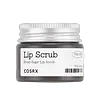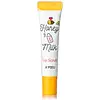What's inside
What's inside
 Key Ingredients
Key Ingredients

No key ingredients
 Benefits
Benefits

 Concerns
Concerns

 Ingredients Side-by-side
Ingredients Side-by-side

Sucrose
HumectantCaprylic/Capric Triglyceride
MaskingGlycerin
HumectantEuphorbia Cerifera Wax
Sorbeth-30 Tetraoleate
EmulsifyingButyrospermum Parkii Butter
Skin ConditioningBis-Diglyceryl Polyacyladipate-2
EmollientWater
Skin ConditioningStearalkonium Hectorite
Gel Forming1,2-Hexanediol
Skin ConditioningPropylene Carbonate
SolventTheobroma Cacao Extract
Skin ConditioningEthylhexylglycerin
Skin ConditioningButylene Glycol
HumectantSaccharum Officinarum Extract
MoisturisingDextrin
AbsorbentCitrus Limon Fruit Extract
MaskingHoney
HumectantSucrose, Caprylic/Capric Triglyceride, Glycerin, Euphorbia Cerifera Wax, Sorbeth-30 Tetraoleate, Butyrospermum Parkii Butter, Bis-Diglyceryl Polyacyladipate-2, Water, Stearalkonium Hectorite, 1,2-Hexanediol, Propylene Carbonate, Theobroma Cacao Extract, Ethylhexylglycerin, Butylene Glycol, Saccharum Officinarum Extract, Dextrin, Citrus Limon Fruit Extract, Honey
Water
Skin ConditioningParaffinum Liquidum
EmollientJuglans Regia Shell Powder
AbrasiveCetearyl Alcohol
EmollientGlyceryl Stearate
EmollientPolysorbate 60
EmulsifyingHoney Extract
HumectantMilk Protein Extract
Glycerin
HumectantStearic Acid
CleansingPEG-100 Stearate
1,2-Hexanediol
Skin ConditioningSorbitan Stearate
EmulsifyingHydroxyethyl Acrylate/Sodium Acryloyldimethyl Taurate Copolymer
Emulsion StabilisingDimethicone
EmollientCaprylyl Glycol
EmollientTriethanolamine
BufferingSqualane
EmollientTocopheryl Acetate
AntioxidantSorbitan Isostearate
EmulsifyingCyclopentasiloxane
EmollientDimethicone/Vinyl Dimethicone Crosspolymer
Skin ConditioningCarbomer
Emulsion StabilisingPhenoxyethanol
PreservativeDisodium EDTA
Parfum
MaskingCI 77891
Cosmetic ColorantWater, Paraffinum Liquidum, Juglans Regia Shell Powder, Cetearyl Alcohol, Glyceryl Stearate, Polysorbate 60, Honey Extract, Milk Protein Extract, Glycerin, Stearic Acid, PEG-100 Stearate, 1,2-Hexanediol, Sorbitan Stearate, Hydroxyethyl Acrylate/Sodium Acryloyldimethyl Taurate Copolymer, Dimethicone, Caprylyl Glycol, Triethanolamine, Squalane, Tocopheryl Acetate, Sorbitan Isostearate, Cyclopentasiloxane, Dimethicone/Vinyl Dimethicone Crosspolymer, Carbomer, Phenoxyethanol, Disodium EDTA, Parfum, CI 77891
 Reviews
Reviews

Ingredients Explained
These ingredients are found in both products.
Ingredients higher up in an ingredient list are typically present in a larger amount.
1,2-Hexanediol is a synthetic liquid and another multi-functional powerhouse.
It is a:
- Humectant, drawing moisture into the skin
- Emollient, helping to soften skin
- Solvent, dispersing and stabilizing formulas
- Preservative booster, enhancing the antimicrobial activity of other preservatives
Glycerin is already naturally found in your skin. It helps moisturize and protect your skin.
A study from 2016 found glycerin to be more effective as a humectant than AHAs and hyaluronic acid.
As a humectant, it helps the skin stay hydrated by pulling moisture to your skin. The low molecular weight of glycerin allows it to pull moisture into the deeper layers of your skin.
Hydrated skin improves your skin barrier; Your skin barrier helps protect against irritants and bacteria.
Glycerin has also been found to have antimicrobial and antiviral properties. Due to these properties, glycerin is often used in wound and burn treatments.
In cosmetics, glycerin is usually derived from plants such as soybean or palm. However, it can also be sourced from animals, such as tallow or animal fat.
This ingredient is organic, colorless, odorless, and non-toxic.
Glycerin is the name for this ingredient in American English. British English uses Glycerol/Glycerine.
Learn more about GlycerinWater. It's the most common cosmetic ingredient of all. You'll usually see it at the top of ingredient lists, meaning that it makes up the largest part of the product.
So why is it so popular? Water most often acts as a solvent - this means that it helps dissolve other ingredients into the formulation.
You'll also recognize water as that liquid we all need to stay alive. If you see this, drink a glass of water. Stay hydrated!
Learn more about Water